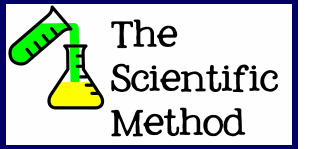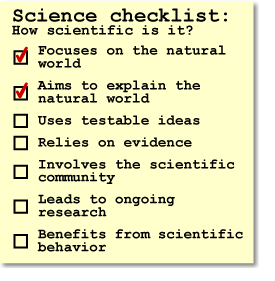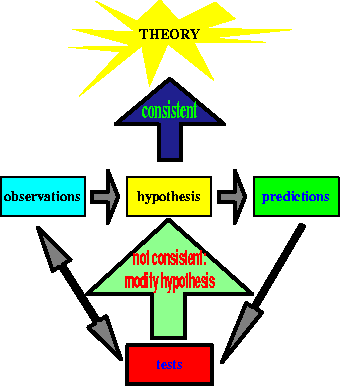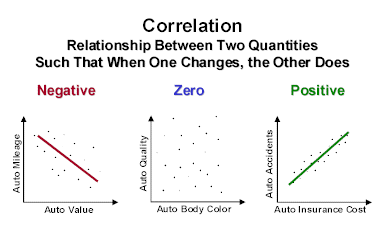
 This is how scientists go about observing,
analyzing the results of their observations, and arriving at
predictions. The key thing about this method is that it is
designed to arrive at valid conclusions in spite of human
fallibility.
This is how scientists go about observing,
analyzing the results of their observations, and arriving at
predictions. The key thing about this method is that it is
designed to arrive at valid conclusions in spite of human
fallibility.
We do not propose to discuss all aspects of
the Scientific Method. There are any number of online
sources that do that quite well (see below). Rather, we
wish to address some key aspects of the Scientific Method that
deal with many of the criticism raised toward science.
General Outline: This is a
brief look at how the Scientific Method works
The scientific method is the best
way yet discovered for finding the truth and differentiating it
from lies and delusion. The simple version looks something like
this:
1. Observe some aspect of the universe.
2. Invent a tentative description, called a
hypothesis, that is consistent with what you have
observed.
3. Use the hypothesis to make predictions.
4. Test those predictions by experiments or
further observations and modify the hypothesis in the
light of your results.
5. Repeat steps 3 and 4 until there are no
discrepancies between theory and experiment and/or
observation.

When consistency is obtained the
hypothesis becomes a theory and provides a coherent set
of propositions which explain a class of phenomena. A theory is
then a framework within which observations are explained and
predictions are made.
Empirical:
As
noted above, the scientific method involves empirical
observation of observable facts.
Prediction:
The scientific method involves predicting outcomes based on cause and effect
relationships. This is a key aspect of validity in
science.
Experimental studies:
This is the means for testing predicted outcomes,
usually in the laboratory.
Experiments are the surest test for causality. There are a
number of different experimental designs.
 Perhaps the
simplest experiment involves establishing a condition, or
situation (e.g., twenty potted plants), dividing that into two
parts, the experimental group and the control group (ten potted
plants in each group) and apply the experimental condition to
one group (water ten potted plants and not water the other ten
potted plants) and observe the result (the experimental group
lives, the control group dies.
Perhaps the
simplest experiment involves establishing a condition, or
situation (e.g., twenty potted plants), dividing that into two
parts, the experimental group and the control group (ten potted
plants in each group) and apply the experimental condition to
one group (water ten potted plants and not water the other ten
potted plants) and observe the result (the experimental group
lives, the control group dies.
Non-experimental studies:
Sometimes it's not possible to conduct a laboratory experiment, so other
forms of research have been developed. While they suggest
causal relationships, they do not prove them. These often
rely on increasingly sophisticated forms of correlational data
analysis (e.g. multiple regression and discriminate function
analysis).

Correlational study:
exams how one variable changes when another variable changes.
While it does not demonstrate causality, it suggests there is
some sort of relationship between the two variables. Here
are three graphs showing a hypothetical correlational
relationship between to variables concerning automobiles.
In the negative correlation, the more mileage on the car the
lower the value (when one variable goes up, the other goes down), while in the positive correlation, the few
accidents the lower the cost of insurance (when one variable
goes up, so does the other), and a zero correlation occurs when
body color changes and auto quality changes (when one variable
changes, the other doesn't change).

Published methods, data analysis
and results:
The key here is the science is a
scholarly enterprise, which means that it is based on shared
information, which is done by means of publications in
scientific journals, and text books. This was a major
advance in how humans came to understand the world we live in. As
a result, scientists are
required to share all aspects of their research, including their
source of data, methods of collecting data, data analysis and
results, all of which provides for...
Peer review and
replication (a group effort):
Scientific findings, including
the validity of the research methodology and the potential
application beyond the experiment itself, are reviewed by other
scientists. In other words, multiple scientists are
involved in assessing published research findings. There are two
main steps in this process.
Peer review occurs
when research is submitted for publication. The article is sent to
other researchers who assess the methodology and findings and then
report whether they think the research merits publication. This
does not guarantee that the research is fully valid. It simply
says it is worth sharing. That is a key element of science, the
sharing of information so others can also examine and work with it.
It is important to note that
not all science publications are peer reviewed, and scientists know
which ones are and the level of review applied by journals. In the
case of those that don't use journal review, articles are published in
order to make them public and allow for follow-up research.
Replication involves
further repeated observation and
experimentation (i.e. follow-up research), often by more than one scientist, is
required to validate the observation and the findings (you may
recall that some years ago, some scientists ran an experiment
that produced cold fusion, a highly desirable possible energy
source, but no one could replicate their results).
Three levels of
acceptance:
Scientific Method works with hypotheses, models
and theories (laws of nature). A hypothesis is something
used to look at specific predicted research outcomes. A
model is used when it is known there are probable limitations to
validity but a working framework is necessary for communication
between scientists and to help direct ongoing research. A
theory, or law, contains a hypothesis (or a number of
hypotheses) that have been confirmed.
Scientific consensus:
First, this does NOT involve agreement of opinion, or
belief. What it does involve is the three levels of acceptance
listed above. Scientists scrutinize each other, arrive at
agreement about which hypotheses have merit and utility, which models
result in empirically sound research (whether causal, or correlational).
And, finally, which theories, or laws can be supported and shared (e.g.,
the law of gravity).
Growth and change:
Of course, over time, given the goals and methods of
science, things (including the consensus) change. The body of scientific knowledge is constantly growing and
changing (e.g., the previous models of the atom have been
significantly altered as more research has been conducted) At
the same research methods have grown, as has data analysis
techniques (more use of fuzzy logic and probability).
Einstein's theory of relativity expanded our view of physics
beyond earlier laws of Newton.
Faulty, or Invalid Research:
Yes, this can happen. The Scientific Method makes it more
difficult, but it can't prevent all errors, or malfeasance.
Nothing can do that. For the most part, there are two ways
for invalid research to get published, and in most cases it will
be rectified (because some scientist will figure it out).
Unfortunately, many of current criticisms of science are
directed at the scientists themselves (e.g., "They're just in it
for the money"). When these lack any review of the
research, itself, these are simply ad hominem attacks (see our
discussion of logical fallacies for more about this), and thus
dismissible.
But scientists are human and thus fallible, so they do make
mistakes, either on purpose, or by accident.
Intentional: Well, yes there are unscrupulous and
malfeasant folks that sometimes end up in the scientific
community.
A primary form of intentional invalidity is
simply faking the data (making it up). This has happened.
We often end up knowing that it is faked, either because no one
has been able to replicate the data, or someone blew the
whistle, or both.
Another example of intentional support of invalid research has
been faked peer review. Over time, these become apparent,
and the fact that so many such fake reviews (usually in limited
topic areas) have come to light verifies the extent to which
scientists oversee each other.
Unintentional: Again, scientists make mistakes, no matter
how hard they try.
Methodological errors:
This can involve something as
simple as malfunctioning measurement equipment to the wrong
choice of subjects for an experiment.
For example, many years ago, a scientist studying attention used
cats in his study to see how they responded to stimuli,
specifically sound localization. His results (which were
replicated) found cats didn't orient well to sounds from behind.
So everyone accepted this, until someone realized cats turn
their ears, and if they couldn't hear what was behind, because
their ears were turned in the wrong direction, then they
wouldn't respond to sounds behind (unless they were quite loud).
He accidentally chose the wrong subjects for his study, and his
results were valid for cats but but not because of the cognitive
(brain oriented) process of attention, and they could not be
generalized to other organisms.
Biases:
Scientists have biases, just like everyone, but
they are supposed to occur in places where they have the least
chance of producing invalid results. So, scientists get to
choose the things they want to study (that's a bias). In
the case of the study above using cats, it was the experimenters
bias that led to using them (they were easily available and
known to be pretty stimuli responsive).
The primary bias scientists are expected to avoid is
confirmation bias, that is trying to prove something they
already believe to be true by designing their study to confirm
what they want to find.
Scientists routinely seek to confirm, or disconfirm an
hypothesized result from their research, but they are supposed
to do the research in a way to allow any and all possible
results. A classic example of disconfirming results
occurred some years ago, when psychologists set out to
demonstrate that depressed people tend to see things more
negatively than they really are. They found out they were
wrong, that in some cases (particularly those where there was a
risk of a highly negative event occurring) people who were
depressed saw reality better than non-depressed individuals,
which led them to seeing the depressed folks as "sadder but
wiser" (if you do an online search of this "sadder but wiser"
you can read about this research).
Confirmation bias can and often does lead
to biases in research design (e.g., choice of data to collect,
from what source and how to analyze it), which is often caught
in peer review. Sometimes errors in methodology produce
valid results for the study alone (called internal validity) but
can't be generalized (external validity). This can
particularly happen when a sample is taken from the wrong source
(as in the study of cats mentioned above), or when disconfirming
date is ignored.
A classic example of this was research conducted some years back
to prove that gun ownership prevents crime. The study
concluded lower crime rate in a town that had more people armed
with guns, in comparison to a similar town with less gun
ownership. The researcher failed to collect data from high
crime, often inner city communities, where there is a very high
rate of gun ownership and possession, as well as above average
crime rates (especially homicide). The study results were
valid internally but could not be generalized to all communities
due to sampling error.
Finally, there is a kind of bias known of as a "paradigm," which
is a broad philosophical and/or conceptual framework. An
example would be the notion that the Earth is the center of the
universe.
Scientists are generally aware of this issue and the shifts in
paradigms that have occurred over time, so, while they may
operate under a given paradigm (complex computations were provided
to explain the movement of the planets when it was thought that
the Earth was the center of the universe, complex computations
that worked under that paradigm), but revolutionary
thinkers and researchers help change the paradigms (e.g.,
science moved
from Newtonian physics, to relativity and quantum mechanics).
Self Correcting:
Science arose as a means for dealing with human fallibility in
the quest for understanding and predicting the world around us.
As discussed above, by making it such a group effort, it created
ongoing self-scrutiny. The result has been research that
has been withdrawn from publication. Changes in peer
review methods. Ongoing paradigm shifts.

In this case, two words: Science and Technology
Science can lead to technology, but they are not the same.
This is an important distinction. Technology, or the way
we do things, predates science by many millennia.
Technology is the way we use things to manipulate and change the
world around us. It dates all the way back to the earliest
human tools. But as science, a rather recent activity, has
developed, it has led to more and more sophisticated technology
(e.g., tools), such as light bulbs. Early technology
relied on trial-and-error, but the advent of systematic science
led to much more rapid technological development.
 For
a YouTube description of the Scientific Method by Physicist
Richard Feynman
For
a YouTube description of the Scientific Method by Physicist
Richard Feynman
 For
an online search for further information about the Scientific
Method
For
an online search for further information about the Scientific
Method
 For
an extended discussion of the Scientific Method available
on the internet
For
an extended discussion of the Scientific Method available
on the internet
 To
go to the introduction to science
To
go to the introduction to science
 To
go to the Articles Page
To
go to the Articles Page